Haodi Jiang
BEACON: Behavioral Malware Classification with Large Language Model Embeddings and Deep Learning
Sep 18, 2025Abstract:Malware is becoming increasingly complex and widespread, making it essential to develop more effective and timely detection methods. Traditional static analysis often fails to defend against modern threats that employ code obfuscation, polymorphism, and other evasion techniques. In contrast, behavioral malware detection, which monitors runtime activities, provides a more reliable and context-aware solution. In this work, we propose BEACON, a novel deep learning framework that leverages large language models (LLMs) to generate dense, contextual embeddings from raw sandbox-generated behavior reports. These embeddings capture semantic and structural patterns of each sample and are processed by a one-dimensional convolutional neural network (1D CNN) for multi-class malware classification. Evaluated on the Avast-CTU Public CAPE Dataset, our framework consistently outperforms existing methods, highlighting the effectiveness of LLM-based behavioral embeddings and the overall design of BEACON for robust malware classification.
Reconstruction of Solar EUV Irradiance Using CaII K Images and SOHO/SEM Data with Bayesian Deep Learning and Uncertainty Quantification
Aug 09, 2025Abstract:Solar extreme ultraviolet (EUV) irradiance plays a crucial role in heating the Earth's ionosphere, thermosphere, and mesosphere, affecting atmospheric dynamics over varying time scales. Although significant effort has been spent studying short-term EUV variations from solar transient events, there is little work to explore the long-term evolution of the EUV flux over multiple solar cycles. Continuous EUV flux measurements have only been available since 1995, leaving significant gaps in earlier data. In this study, we propose a Bayesian deep learning model, named SEMNet, to fill the gaps. We validate our approach by applying SEMNet to construct SOHO/SEM EUV flux measurements in the period between 1998 and 2014 using CaII K images from the Precision Solar Photometric Telescope. We then extend SEMNet through transfer learning to reconstruct solar EUV irradiance in the period between 1950 and 1960 using CaII K images from the Kodaikanal Solar Observatory. Experimental results show that SEMNet provides reliable predictions along with uncertainty bounds, demonstrating the feasibility of CaII K images as a robust proxy for long-term EUV fluxes. These findings contribute to a better understanding of solar influences on Earth's climate over extended periods.
Deep Computer Vision for Solar Physics Big Data: Opportunities and Challenges
Sep 07, 2024Abstract:With recent missions such as advanced space-based observatories like the Solar Dynamics Observatory (SDO) and Parker Solar Probe, and ground-based telescopes like the Daniel K. Inouye Solar Telescope (DKIST), the volume, velocity, and variety of data have made solar physics enter a transformative era as solar physics big data (SPBD). With the recent advancement of deep computer vision, there are new opportunities in SPBD for tackling problems that were previously unsolvable. However, there are new challenges arising due to the inherent characteristics of SPBD and deep computer vision models. This vision paper presents an overview of the different types of SPBD, explores new opportunities in applying deep computer vision to SPBD, highlights the unique challenges, and outlines several potential future research directions.
Super-Resolution of SOHO/MDI Magnetograms of Solar Active Regions Using SDO/HMI Data and an Attention-Aided Convolutional Neural Network
Mar 27, 2024Abstract:Image super-resolution has been an important subject in image processing and recognition. Here, we present an attention-aided convolutional neural network (CNN) for solar image super-resolution. Our method, named SolarCNN, aims to enhance the quality of line-of-sight (LOS) magnetograms of solar active regions (ARs) collected by the Michelson Doppler Imager (MDI) on board the Solar and Heliospheric Observatory (SOHO). The ground-truth labels used for training SolarCNN are the LOS magnetograms collected by the Helioseismic and Magnetic Imager (HMI) on board the Solar Dynamics Observatory (SDO). Solar ARs consist of strong magnetic fields in which magnetic energy can suddenly be released to produce extreme space weather events, such as solar flares, coronal mass ejections, and solar energetic particles. SOHO/MDI covers Solar Cycle 23, which is stronger with more eruptive events than Cycle 24. Enhanced SOHO/MDI magnetograms allow for better understanding and forecasting of violent events of space weather. Experimental results show that SolarCNN improves the quality of SOHO/MDI magnetograms in terms of the structural similarity index measure (SSIM), Pearson's correlation coefficient (PCC), and the peak signal-to-noise ratio (PSNR).
A Deep Learning Approach to Generating Photospheric Vector Magnetograms of Solar Active Regions for SOHO/MDI Using SDO/HMI and BBSO Data
Nov 04, 2022Abstract:Solar activity is usually caused by the evolution of solar magnetic fields. Magnetic field parameters derived from photospheric vector magnetograms of solar active regions have been used to analyze and forecast eruptive events such as solar flares and coronal mass ejections. Unfortunately, the most recent solar cycle 24 was relatively weak with few large flares, though it is the only solar cycle in which consistent time-sequence vector magnetograms have been available through the Helioseismic and Magnetic Imager (HMI) on board the Solar Dynamics Observatory (SDO) since its launch in 2010. In this paper, we look into another major instrument, namely the Michelson Doppler Imager (MDI) on board the Solar and Heliospheric Observatory (SOHO) from 1996 to 2010. The data archive of SOHO/MDI covers more active solar cycle 23 with many large flares. However, SOHO/MDI data only has line-of-sight (LOS) magnetograms. We propose a new deep learning method, named MagNet, to learn from combined LOS magnetograms, Bx and By taken by SDO/HMI along with H-alpha observations collected by the Big Bear Solar Observatory (BBSO), and to generate vector components Bx' and By', which would form vector magnetograms with observed LOS data. In this way, we can expand the availability of vector magnetograms to the period from 1996 to present. Experimental results demonstrate the good performance of the proposed method. To our knowledge, this is the first time that deep learning has been used to generate photospheric vector magnetograms of solar active regions for SOHO/MDI using SDO/HMI and H-alpha data.
Inferring Line-of-Sight Velocities and Doppler Widths from Stokes Profiles of GST/NIRIS Using Stacked Deep Neural Networks
Oct 08, 2022
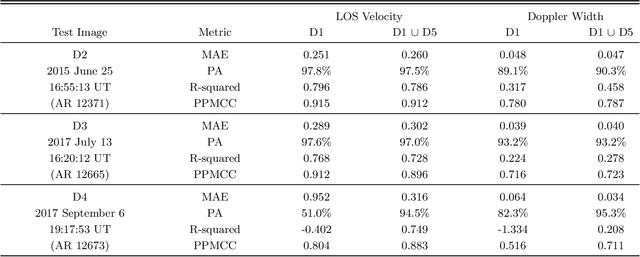
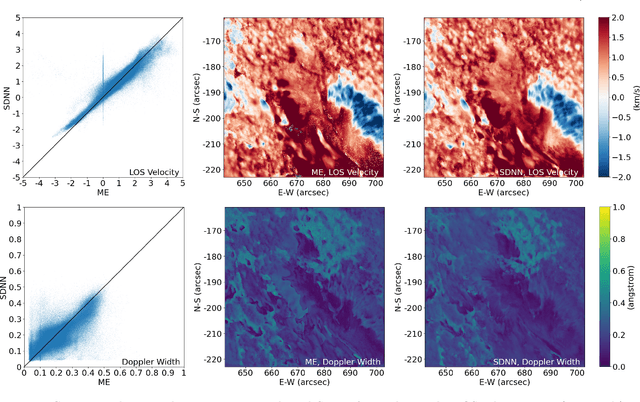

Abstract:Obtaining high-quality magnetic and velocity fields through Stokes inversion is crucial in solar physics. In this paper, we present a new deep learning method, named Stacked Deep Neural Networks (SDNN), for inferring line-of-sight (LOS) velocities and Doppler widths from Stokes profiles collected by the Near InfraRed Imaging Spectropolarimeter (NIRIS) on the 1.6 m Goode Solar Telescope (GST) at the Big Bear Solar Observatory (BBSO). The training data of SDNN is prepared by a Milne-Eddington (ME) inversion code used by BBSO. We quantitatively assess SDNN, comparing its inversion results with those obtained by the ME inversion code and related machine learning (ML) algorithms such as multiple support vector regression, multilayer perceptrons and a pixel-level convolutional neural network. Major findings from our experimental study are summarized as follows. First, the SDNN-inferred LOS velocities are highly correlated to the ME-calculated ones with the Pearson product-moment correlation coefficient being close to 0.9 on average. Second, SDNN is faster, while producing smoother and cleaner LOS velocity and Doppler width maps, than the ME inversion code. Third, the maps produced by SDNN are closer to ME's maps than those from the related ML algorithms, demonstrating the better learning capability of SDNN than the ML algorithms. Finally, comparison between the inversion results of ME and SDNN based on GST/NIRIS and those from the Helioseismic and Magnetic Imager on board the Solar Dynamics Observatory in flare-prolific active region NOAA 12673 is presented. We also discuss extensions of SDNN for inferring vector magnetic fields with empirical evaluation.
* 16 pages, 8 figures
Tracing Halpha Fibrils through Bayesian Deep Learning
Jul 16, 2021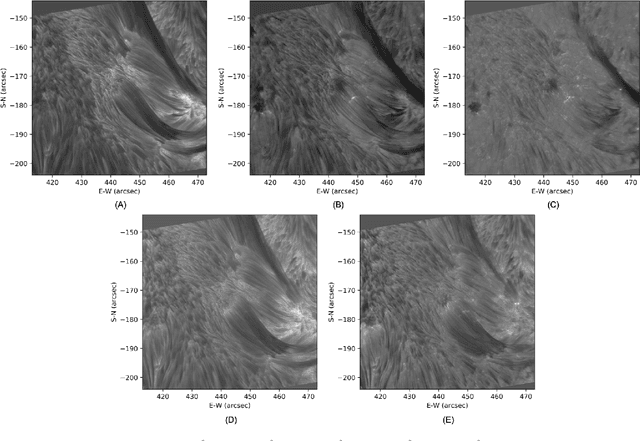

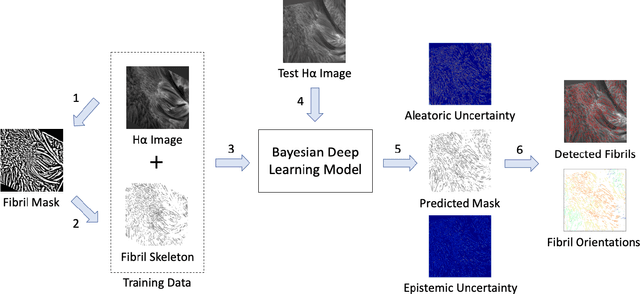

Abstract:We present a new deep learning method, dubbed FibrilNet, for tracing chromospheric fibrils in Halpha images of solar observations. Our method consists of a data pre-processing component that prepares training data from a threshold-based tool, a deep learning model implemented as a Bayesian convolutional neural network for probabilistic image segmentation with uncertainty quantification to predict fibrils, and a post-processing component containing a fibril-fitting algorithm to determine fibril orientations. The FibrilNet tool is applied to high-resolution Halpha images from an active region (AR 12665) collected by the 1.6 m Goode Solar Telescope (GST) equipped with high-order adaptive optics at the Big Bear Solar Observatory (BBSO). We quantitatively assess the FibrilNet tool, comparing its image segmentation algorithm and fibril-fitting algorithm with those employed by the threshold-based tool. Our experimental results and major findings are summarized as follows. First, the image segmentation results (i.e., detected fibrils) of the two tools are quite similar, demonstrating the good learning capability of FibrilNet. Second, FibrilNet finds more accurate and smoother fibril orientation angles than the threshold-based tool. Third, FibrilNet is faster than the threshold-based tool and the uncertainty maps produced by FibrilNet not only provide a quantitative way to measure the confidence on each detected fibril, but also help identify fibril structures that are not detected by the threshold-based tool but are inferred through machine learning. Finally, we apply FibrilNet to full-disk Halpha images from other solar observatories and additional high-resolution Halpha images collected by BBSO/GST, demonstrating the tool's usability in diverse datasets.
Identifying and Tracking Solar Magnetic Flux Elements with Deep Learning
Aug 27, 2020
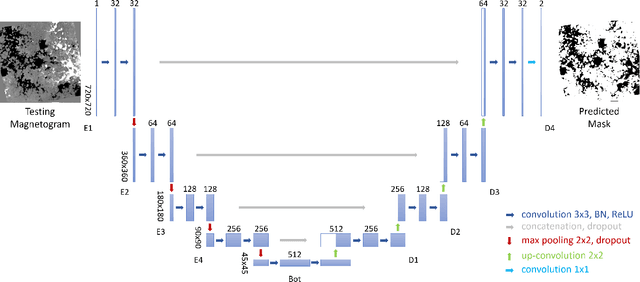

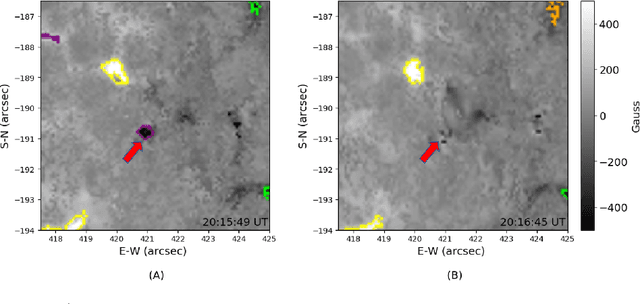
Abstract:Deep learning has drawn a lot of interest in recent years due to its effectiveness in processing big and complex observational data gathered from diverse instruments. Here we propose a new deep learning method, called SolarUnet, to identify and track solar magnetic flux elements or features in observed vector magnetograms based on the Southwest Automatic Magnetic Identification Suite (SWAMIS). Our method consists of a data pre-processing component that prepares training data from the SWAMIS tool, a deep learning model implemented as a U-shaped convolutional neural network for fast and accurate image segmentation, and a post-processing component that prepares tracking results. SolarUnet is applied to data from the 1.6 meter Goode Solar Telescope at the Big Bear Solar Observatory. When compared to the widely used SWAMIS tool, SolarUnet is faster while agreeing mostly with SWAMIS on feature size and flux distributions, and complementing SWAMIS in tracking long-lifetime features. Thus, the proposed physics-guided deep learning-based tool can be considered as an alternative method for solar magnetic tracking.
* 17 pages, 12 figures
 Add to Chrome
Add to Chrome Add to Firefox
Add to Firefox Add to Edge
Add to Edge